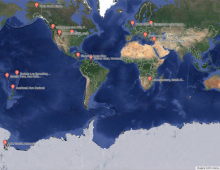“Some of us did not believe that microbes are infinitely diverse,” despite a prevailing assumption, said Steve Giovannoni, who studies bacterioplankton at Oregon State University and who was not involved in the study. “That very high diversity is channeled into patterns, and we’re starting to see what those patterns look like.” Read the full story in…
Discovering diversity, one cell at a time
The game where one has to guess how many jelly beans or marbles can fill a jar should never be played with the cyanobacterium Prochlorococcus. By some estimates, in a single liter of water as many as 100 million cells of this tiny bacterium can be found. These important organisms serve as the base of…
Every Day is Earth Day @JGI
More than four decades ago, the first celebration of Earth Day raised the idea of protecting the environment to a greater public awareness. Today, the annual event is a reminder of the longstanding goal to provide a cleaner, healthier and sustainable environment for everyone to live in. Here at the U.S. Department of Energy Joint…
Deciphering the virulence of a fern fungus
Researchers annotate genome of the smallest known fungal plant pathogen. The Science: Researchers sequenced and analyzed the genome of Mixia osmundea, the smallest fungal plant pathogen (13.6 million bases) to date, to provide insight into its mode of pathogenicity and reproductive biology. The Impact: Aside from learning how the fungal pathogen reproduces, genome annotation revealed…
Microbes in Antarctic lake divvy up the waters
Recently sequenced microbes living in Deep Lake are mostly specialists, cornering different niches in the lake ecosystem The Science: Four microbes dominate in the Antarctica’s Deep Lake, making up 70% of the microbial community. They belong to a group called haloarchaea that require high salt concentrations to grow and are naturally adapted to extreme conditions…
The Genomics of Energy & Environment – in Poetry
In honor of National Poetry Month, we’re celebrating an underutilized method of communicating our science: poetry. According to Merriam-Webster, poetry is defined as, “writing that formulates a concentrated imaginative awareness of experience in language chosen and arranged to create a specific emotional response through meaning, sound, and rhythm.” As proof that science can (and has)…
Sponges that sponge off bacteria
Medical compounds harvested from a marine sponge are actually produced by symbiotic bacteria living in the sponges. The Science: The research team used single-cell genome analysis, and metagenomic sequencing to find that just two bacterial tenants of a marine sponge, Theonella swinhoei, make medically important compounds called polyketides. Both bacteria belong an uncultivated genus, Enthotheonella. The research…
Great Prairie soil study in Biomass magazine
“During the study, MSU researchers sought to compare the microbial populations of different soils sampled from sites that were once native prairie with 100 years of agricultural cultivation. The experiment yielded nearly 400 billion letters of code, which amounts to more than 130 human genome equivalents.” Learn more about the complexities of soil and then…
A Tale of Two Data Sets: New DNA Analysis Strategy Helps Researchers Cut through the Dirt
For soil microbiology, it is the best of times. While no one has undertaken an accurate census, a spoonful of soil holds hundreds of billions of microbial cells, encompassing thousands of species. “It’s one of the most diverse microbial habitats on Earth, yet we know surprisingly little about the identities and functions of the microbes…
Biofuels from a floating water weed
The recently sequenced genome of Spirodela polyrhiza showcases why the plant makes an excellent raw source for biofuels. The Science: Duckweed is one of the smallest and fastest-growing flowering plants that can be a hard-to-control weed in ponds and small lakes. Sequencing the genome of Greater Duckweed (Spirodela polyrhiza) has provides clues about how the tiny…







